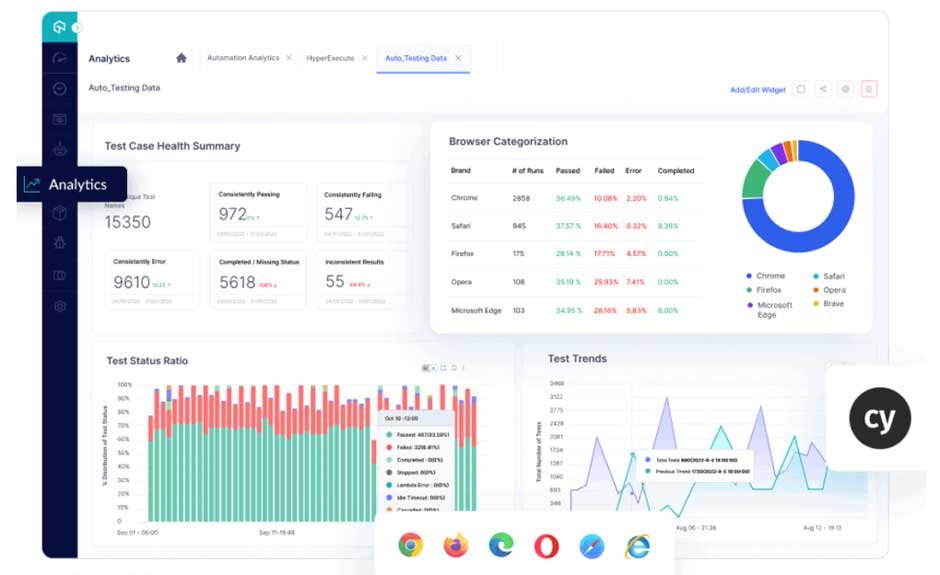Automation testing is a revolutionary trend that is constantly influencing application testing efficiency and application quality. By implementing automation testing, the app developers can massively improve the coordination between the development, testing, and production teams of the app company.
A major benefit of this process is that it allows the developers and testers to quickly remove bugs and errors as soon as they appear in the core infrastructure of the app. With the implementation of test automation, the developers can also help to improve the quality of the application and create a positive image for the brand. While implementing Cypress test automation, the developers can use all of these features to improve the viability of the test cases.
With this article, we are going to explore some of the best practices that the automation testers can implement to improve the productivity and quality of the Cypress testing environment. We will also discuss how various tools and platforms can help in the implementation of these practices.
Understanding Automation testing and Cypress
Automation testing is an efficient replacement of the previously used complete manual test cases. This is because instead of using a manual testing team, the system will utilize a series of text files consisting of statistical data and pre-determined test parameters. Using these data, the system can communicate with the app while emulating human interactions. Based on these interactions, the system will generate a detailed test report showing the stability and usability of the app undergoing the development process. In this context, the developers can also change the text files to customize the app testing environment according to their project requirements.
With the proper implementation of automation testing, the developers can boost the Cypress test cases in the following ways:
- Test automation will eliminate the burden of executing repetitive test cases like regression testing and data analysis testing. By saving this time, the developers can invest it in developing unique features that can be rolled out in a future application update.
- Automation testing reports are much more accurate compared to manual testing. This is because the entire test suite is conducted by the system without any involvement of human developers. Moreover, the test environment can run the test cases 24 hours around the clock which is not comparable to human abilities.
- While implementing automation testing, the developers can integrate various automated testing tools, plugins, and libraries that have a critical role in boosting the quality of the app that is currently being developed. It also helps to integrate Agile methodologies to combine the working structure of all the teams in the app development company.
- Automation testing also has a role in improving the company’s time allocation and resource management. For instance, it helps save a lot of expenses by removing the need to set up and maintain a human testing team.
On the other hand, Cypress is an automation web testing tool that is not only easy and reliable but also compatible fast for executing the test cases. The app developers primarily use Cypress for testing all the elements present in modern web apps. Since Cypress is open-source, the developers can utilize all of its features without investing any additional platform Charges. Some of the most useful features of Cypress automation testing include the performance of unit testing, Java web integration, and execution of end-to-end test cases. Moreover, the core framework of Cypress works on the JavaScript programming language which helps eliminate the lengthy learning curves during the transition process.
Best Practices for Cypress Test Automation
Based on our research and understanding, we have created a list of some of the best practices to implement while executing Cypress test automation. These practices will help the app developers to properly configure the test environment, improve the test execution speed, and assist in the clean-up process:
1. Integration of Cloud Testing
With the implementation of cloud testing with Cypress test automation, the developers can execute real device testing through remote servers. This process not only saves the expense of a physical test bench but also integrates additional features. Some of the most useful features include access to legacy devices and elimination of Geolocation barriers. LambdaTest is one of the most prominent names in the segment of cloud-based app testing platforms.
2. Test Organisation
While implementing Cypress test automation, app developers need to organize the test cases according to their priority. This will help them to improve the test efficiency by configuring the critical test cases and maintaining the stability of the core app infrastructure. There are various tools available in the market that can help app developers group and organize test cases.
3. Implementation of Descriptive Test Names
Since modern elements consist of thousands of different test instances, it can be very difficult for the app testers to keep track of all of them. By properly naming the test cases according to the target elements, the testers can highly simplify the test tracking process. It is also important to maintain an activity log to store all the test instances.
4. Isolating the Test Data in the Script
Isolating the test data helps the app testers improve the maintainability and lifetime of the automation test data for Cypress. They can use fixtures or APIs to isolate these data from the production data while running the test cases.
5. Parallel test Execution
Since modern apps consist of thousands of different elements that need to be tested, it can be a lengthy process when it is executed individually. On the other hand, with the help of parallel test execution, the developers can run thousands of such test cases on different configurations and machines at the same time.
6. Implementation of Test Reporting and Analysis
Test reports provide vital information to understand the performance and stability of the application. So the developers must have proper tools to keep track of the bugs and errors and provide additional data in the test reports. Cloud platforms like LambdaTest have native support for comprehensive test report generation.
7. Use of Performance Testing
The primary function of Cypress is to initiate functional testing on web apps. So the app developers must consider a 3rd party tool to initiate performance testing on the web applications. The combination of both these test cases is crucial to guarantee the stability of the app when exposed to real-world parameters.
LambdaTest and its Integration with Cypress Testing
LambdaTest is an AI-powered test orchestration and test execution platform that allows the developers to coordinate and execute the automation test cases. Using the LambdaTest real device cloud, the app developers can run the Cypress test cases on thousands of real devices through remote servers. It is also possible to integrate these test reports with simulation software to further boost the accuracy of the test results. LambdaTest also helps app developers use Cypress testing for initiating cross-browser testing on web apps.
The integration of LambdaTest with Cypress testing can help boost the app development project in the following ways:
- It is a very simple process to configure LambdaTest and set up the testing environment for executing Cypress test cases. Using the following command, the app testers can complete the LambdaTest configuration process:
// cypress.json
{
“env”: {
“LT_USERNAME”: “your_lambda_test_username”,
“LT_ACCESS_KEY”: “your_lambda_test_access_key”
}
}
- Using the LambdaTest API, the app developers can run the Cypress test cases on more than 50 different browsers and operating systems at the same time. For this process, LambdaTest will use the feature of parallel test execution. In this process, the system analyses the testing parameters and forwards them to all the target elements simultaneously for the execution process. Using the following code snippet, the app developers can initiate LambdaTest parallel testing while using Cypress test cases.
// cypress.json
{
“env”: {
“LT_USERNAME”: “your_lambda_test_username”,
“LT_ACCESS_KEY”: “your_lambda_test_access_key”,
“CYPRESS_RECORD_KEY”: “your_cypress_record_key”
},
“testFiles”: “**/*.{feature,features}”
}
// cypress/integration/my-cucumber-steps.js
const { Given, When, Then } = require(“cypress-cucumber-preprocessor/steps”);
Given(“I am on the homepage”, () => {
// Set up LambdaTest configuration
cy.viewport(1280, 720); // Set the viewport size
cy.visit(“https://example.com”); // Replace with your application URL
cy.lambdatestStart();
});
When(“I perform some actions”, () => {
// Your test logic goes here
cy.get(“#elementId”).should(“be.visible”);
});
Then(“I should see some results”, () => {
// Your assertion logic goes here
cy.get(“#result”).should(“contain.text”, “Expected Result”);
});
After(() => {
// Clean up and end the LambdaTest session
cy.lambdatestEnd();
});

- The LambdaTest real device testing cloud provides access to thousands of legacy devices and browser versions that are impossible to find in the local market. Using this feature, the developers can guarantee the compatibility of their application to those end users who do not update their hardware or software.

- LambdaTest has an extensive support system for the new automation testers which includes the call support common, live chat, and mail option. This feature is aimed to improve the knowledge of the testers about all the tools and features available with this platform. LambdaTest also has a dedicated community for the testers and developers to discuss among themselves.
- After executing the Cypress test cases, LambdaTest generates a detailed test report that shows vital testing statistics including test activity logs, screenshots, and videos. The developers can analyze this data to quickly find out the faulty element in the core infrastructure of the app so we can say that LambdaTest reports help simplify the troubleshooting and debugging process.

- While using LambdaTest for Cypress testing, the application developers can introduce advanced testing processes like performance testing and network throttling testing. These test parameters help the testers understand the stability of the app when it is subjected to real-world scenarios.
- LambdaTest also has elaborate documentation on its official website to guide the new automation testers through various features, tools and methods. The explanation is very simple and also consists of sample test cases. The official documentation also consists of various errors that can arise during the execution of these test cases along with their most accurate solutions.
The Conclusive Views
By implementing all the practices that we discussed in this article, the developers can massively boost the quality of their app development cycles. It is also important to understand the importance of automation testing in the coming years of app development. So the developers should constantly learn all the new trends and innovations that are being constantly integrated into the app testing infrastructure. It is also important to regularly monitor the requirements of the end users to gain additional information about their requirements. These factors are critical as they will help the application developers to customize the testing environment and increase the overall audience reach. The final goal of all these factors is to maintain the company’s position in this competitive segment of the industry.









